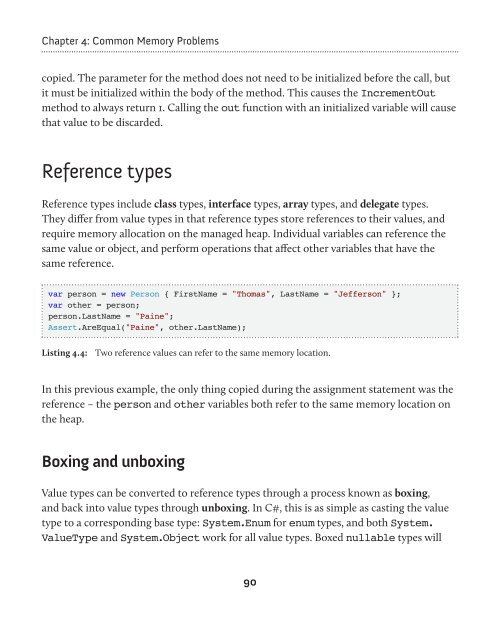Under the Hood of .NET Memory Management - Simple Talk
Under the Hood of .NET Memory Management - Simple Talk
Under the Hood of .NET Memory Management - Simple Talk
You also want an ePaper? Increase the reach of your titles
YUMPU automatically turns print PDFs into web optimized ePapers that Google loves.
Chapter 4: Common <strong>Memory</strong> Problems<br />
copied. The parameter for <strong>the</strong> method does not need to be initialized before <strong>the</strong> call, but<br />
it must be initialized within <strong>the</strong> body <strong>of</strong> <strong>the</strong> method. This causes <strong>the</strong> IncrementOut<br />
method to always return 1. Calling <strong>the</strong> out function with an initialized variable will cause<br />
that value to be discarded.<br />
Reference types<br />
Reference types include class types, interface types, array types, and delegate types.<br />
They differ from value types in that reference types store references to <strong>the</strong>ir values, and<br />
require memory allocation on <strong>the</strong> managed heap. Individual variables can reference <strong>the</strong><br />
same value or object, and perform operations that affect o<strong>the</strong>r variables that have <strong>the</strong><br />
same reference.<br />
var person = new Person { FirstName = "Thomas", LastName = "Jefferson" };<br />
var o<strong>the</strong>r = person;<br />
person.LastName = "Paine";<br />
Assert.AreEqual("Paine", o<strong>the</strong>r.LastName);<br />
Listing 4.4: Two reference values can refer to <strong>the</strong> same memory location.<br />
In this previous example, <strong>the</strong> only thing copied during <strong>the</strong> assignment statement was <strong>the</strong><br />
reference – <strong>the</strong> person and o<strong>the</strong>r variables both refer to <strong>the</strong> same memory location on<br />
<strong>the</strong> heap.<br />
Boxing and unboxing<br />
Value types can be converted to reference types through a process known as boxing,<br />
and back into value types through unboxing. In C#, this is as simple as casting <strong>the</strong> value<br />
type to a corresponding base type: System.Enum for enum types, and both System.<br />
ValueType and System.Object work for all value types. Boxed nullable types will<br />
90











